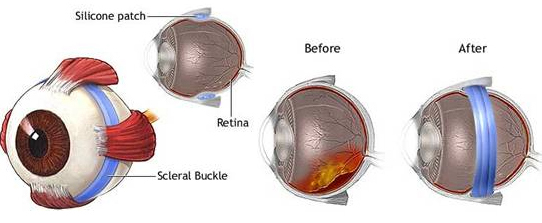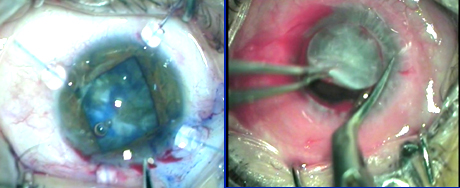
Scleral buckling surgery is one of the ways to treat retinal detachment. It is a method of closing breaks, bringing the two layers of the retina back together, and getting rid of fluid under the retina.
A scleral buckle is produced by a piece of silicone sponge, rubber, or semi-hard plastic that your eye doctor (ophthalmologist) places on the outer layer of the eye (the sclera, or the white of the eye). The material is sewn to the eye to keep it in place. The buckling element is usually left in place permanently.
The element pushes in, or “buckles,” the sclera toward the middle of the eye. This buckling effect on the sclera relieves the pull (traction) on the retina, allowing the retinal tear to settle against the wall of the eye. The buckle effect may cover only the area behind the detachment, or it may encircle the eyeball like a ring.
By itself, the buckle does not prevent a retinal break from opening again. Usually extreme cold (cryopexy) or less commonly, heat (diathermy) or light (laser photocoagulation) is used to scar the retina and hold it in place until a seal forms between the retina and the layer beneath it. The seal holds the layers of the eye together and keeps fluid from getting between them.
Sometimes your eye doctor may inject a gas bubble into your eye to close the break and prevent more fluid from passing through it during surgery. He or she may drain the fluid under the detached retina through a tiny hole in the sclera. If there is only a small amount of fluid, draining it may not be needed. The layer under the retina will absorb it.

Other facts about the surgery
![]() The surgery takes place in a hospital. Detachments can usually be repaired on an outpatient basis (you go home the same day) in the hospital or in an outpatient surgical center.
The surgery takes place in a hospital. Detachments can usually be repaired on an outpatient basis (you go home the same day) in the hospital or in an outpatient surgical center.
![]() Local or general anesthesia may be used.
Local or general anesthesia may be used.
![]() A first-time surgery usually lasts 1 to 2 hours. Repeat surgeries or more complex detachments may take longer.
A first-time surgery usually lasts 1 to 2 hours. Repeat surgeries or more complex detachments may take longer.
What To Expect After Surgery
You may have some pain for a few days after the surgery. Your eye may be swollen, red, or tender for several weeks. Your eye doctor may put drops in your eye that prevent infection and keep the pupil from opening wide (dilating) or closing (constricting). You may have to wear a patch over the eye for a day or more.
Why It Is Done
Scleral buckling is effective in repairing a tear, hole, or break in the retina that has caused the detachment. It is rarely helpful when scar tissue tugging on the retina has caused the detachment (traction detachment).
How Well It Works
Placing a scleral buckle reattaches the retina in most cases. The overall rate of reattachment success rises to above 90% with more than one procedure.
Chances for good vision after surgery are higher if the macula was still attached before surgery. If the detachment affected the macula, good vision after surgery is still possible but less likely.
![]()
